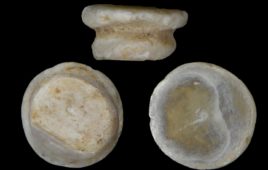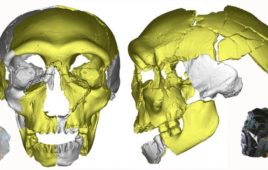 Compared to birds and insects, bats have heavy wings for their body size. Those comparatively cumbersome flappers might seem a detriment to maneuverability, but new research shows that bats’ extra wing mass makes possible a quintessential bit of aerobatics: the ability to land upside down.
Compared to birds and insects, bats have heavy wings for their body size. Those comparatively cumbersome flappers might seem a detriment to maneuverability, but new research shows that bats’ extra wing mass makes possible a quintessential bit of aerobatics: the ability to land upside down.
“Bats land in a unique way,” said Sharon Swartz, a biologist at Brown University who was a senior author of the new research along with Kenny Breuer from Brown’s School of Engineering. “They have to go from flying with their heads forward to executing an acrobatic maneuver that puts them head down and feet up. No other flying animal lands the same way as bats do.”
But exactly how they are able to generate the forces necessary to perform those maneuvers hadn’t been clear.
“When they come in to land they’re not moving very fast, which makes it hard to generate the aerodynamic forces needed to reorient themselves,” Breuer said. “So the question is, how do bats get themselves in position to land?”
Using a special flight enclosure, high-speed cameras and some sophisticated computer modeling, the researchers showed that it has a lot to do with wing mass and inertia.
Bats’ wings are heavy, hand-like assemblages of bone, muscles, joints, tendons and skin. By throwing that extra wing weight around in very precise ways, bats generate inertial forces in order to reorient themselves, rather than relying on the aerodynamic forces generated by pushing against the air. It’s similar, Breuer says, to the way high divers shift their weight to perform flips and twists, or the way cats reorient themselves to land feet-down when they fall.
The findings are published in the journal PLOS Biology.
For the study, led by Attila Bergou, a former postdoctoral researcher in Breuer’s lab, the researchers trained bats from two different species to fly into an enclosure and land on a small piece of mesh fixed to the ceiling. High-speed cameras were able to catch a subtle wing maneuver that the bats make in the fraction of a second before they land.
The videos showed that as the bats approach the ceiling, they retract one of their wings ever so slightly toward their bodies, while flapping the other at full extension. With each wing beat in that asymmetric configuration, the bats rotate a half turn, helping to put them in position to meet the mesh feet first. In subsequent trials, the researchers removed the mesh from the ceiling, leaving the bats nothing to grab on to. Video of those trials showed that, after attempting to land, the bats performed a similar rolling maneuver using their wings in order to reorient themselves for forward flight.
The researchers then used computer simulations to confirm that the effect they were seeing was due to inertia rather than aerodynamics. They used motion capture to record the bats’ movements and then replayed those movements through a computer simulation in which the effects of different forces could be switched on and off. When the simulation was run with aerodynamic forces turned off, the virtual bats were still able to recreate the motion of the real ones.
Similarly, the models allowed manipulation of wing mass parameters. The researchers ran the simulation again with the bats’ wing mass reduced to the proportions of a fruit fly, which have very light wings for their body mass. That simulation showed that the landing rotation was not possible in the absence of aerodynamic forces.
“What this tell us is that in bats, with their heavy wings, it’s the inertial forces that are more important relative to aerodynamics,” Breuer said. “That’s a bit of a counterintuitive conclusion. Normally you’d think that an animal would not want to have such massive wings. But here, it turns out that the mass can be used to some benefit.”
The research sheds light on the basic biology that helps bats fly and land the way they do, but also may be useful in the development of human-made flying machines.
“From an engineering perspective, there’s a lot of interest in drones and flying microvehicles,” Breuer said. “Maneuvering or directing those robotic vehicles is a challenge. The idea here is that using redistribution of mass is not a bad approach to take.”
The work also provided Brown students with a unique educational opportunity.
“Students are an important part of our research group,” Swartz said. “Many undergraduate students collaborate with us in several areas of our research program. One of our co-authors on this work, Lauren Reimnetz, is now is now a veterinarian-in-training at the University of California-Davis. Part of the work for this paper was an element of her undergraduate honors thesis.”
Source: Brown University




